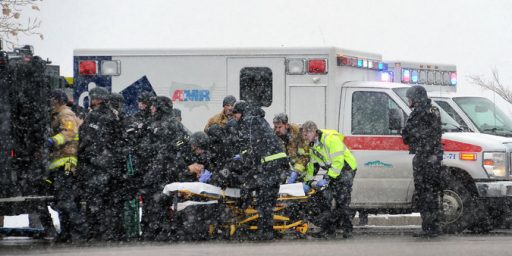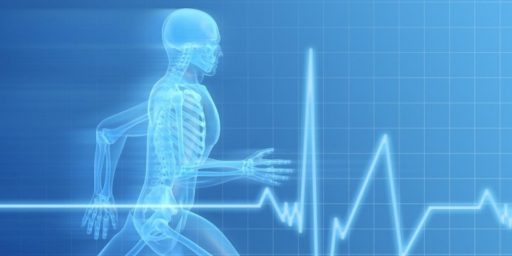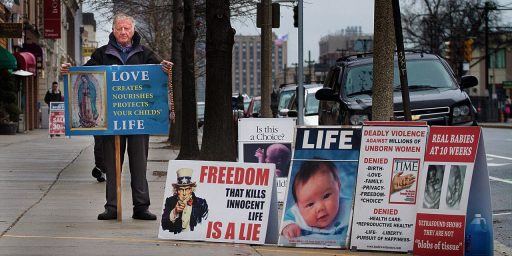Dentists Dying of Mysterious Lung Disease
An estimated 200,000 Americans have Idiopathic Pulmonary Fibrosis. Dental professionals are 23 times more likely to be afflicted.

WaPo (“Dentists keep dying of this lung disease. The CDC can’t figure out why.“):
It’s estimated that about 200,000 people in the United States have Idiopathic Pulmonary Fibrosis (IPF) at any one time.
But the common denominator of a small group of patients at a Virginia clinic over a 15-year period is worrying the Centers for Disease Control and Prevention: Eight were dentists; a ninth was a dental technician.
At first blush, that doesn’t seem a particularly high rate but
The dental professionals were 23 times more likely to have IPF than the rest of the population, the CDC said in its Morbidity and Mortality Weekly Report, released Friday. Something in their workplace environment may have been poisoning them, investigators said, although they don’t know what.
[….]
In April 2016, a Virginia dentist who had just been diagnosed with IPF and was undergoing treatment at a specialty clinic called the CDC with a warning: Several other dental professionals had sought treatment at the same facility. Investigators dug deeper, poring over nearly 900 records of IPF patients at that clinic over a 21-year period and found the nine patients with the common work history.
[…]
Dentists and people who work in their offices are exposed to a specific set of hazards, particularly silica, polyvinyl siloxane, alginate and other toxic substances that can be inhaled when they’re polishing dental appliances or preparing amalgams. Older dentists usually fare worse, both because of increased opportunities for exposure and because they may have practiced at a time when safety standards weren’t as stringent.
[…]
“We do work with materials and with human bioproducts that are potentially damaging to our bodies if we inhale them,” Paul Casamassimo, chief policy officer of the American Academy of Pediatric Dentistry’s Pediatric Oral Health Research and Policy Center, told CNN.
For example, the dentist who alerted the CDC never smoked “but reported not wearing a National Institute for Occupational Safety and Health-certified respirator during dental activities throughout his 40-year dental practice,” the CDC said. During the past 20 years, he started wearing a surgical mask, which still may have been inadequate.
“More work has to be done before we can make any conclusions about the risk dentists or other dental personnel have,” Randall J. Nett, lead author of the study and medical officer with the U.S. Public Health Service, told CNN.
The report keeps saying that doctors don’t know what causes the disease in general, let alone why dentists are disproportionately impacted. That’s not surprising, since that’s what “idiopathic” means (“any disease or condition that arises spontaneously or for which the cause is unknown”).
The story caught my attention because IPF took my father at the age of 66. It is a horrible disease:
IPF causes scarring of the lungs, according to the report. It can be slowed, but nothing can remove the scar tissue. Over time, the lungs have difficulty getting oxygen to vital organs like the heart and brain.
[…]
The median survival age of IPF after diagnosis is three to five years. But first, patients experience shortness of breath, a dry, chronic cough, weight loss, joint and muscle pain and clubbed fingers or toes.
Hopefully, the high incidence in dentists, a group of highly-educated professionals trained to document their work practices in detail, will provide insights that can lead to prevention, if not a cure.






IANAE (E=Epidemiologist), but I hope they are also looking at aerosolized tartar (which is hardened plaque) besides just the chemicals they use in their practice. When you go in for a cleaning and they whip out their ultrasonic thingie and buzz off the plaque/ tartar, and then they use the fine hand tools. Bacteria that may cause relatively minor damage to out teeth and mouths, may be deadly if inhaled deeply.
Come to think of it, just drilling teeth would also create a cloud of tiny aerosolized enamel and dentin particles.
This crosses me a interesting but not particularly meaningful at this stage. They didn’t look at all 200,000 victims of IPF, just a subset of 900. It could be a disease cluster. I would be very interested to see if a much larger sample shows the same trend.
I’ve been going to the same dental practice my entire life (my current dentist is the son of my first dentist). One big change that happened about 20 years ago was they started wearing surgical masks, a face shield, and latex gloves while doing the cleanings. When it first started I thought, “Now that I think about it, I wonder why they weren’t doing that long before now?”, although of course I hadn’t thought of it before then.
Hopefully better practices like that will cut down on things like this.
No, I don’t think fluoride is a some pinko conspiracy, but I’ve always kind of felt the dental profession pushed tooth health over anything else. “You need fluoride in your toothpaste, fluoride in your water, fluoride treatments every 6 months.” And then there’s the x-rays, tooth sealants with BPA, plus the other stuff mentioned in the article. We’ve just had to tell our dentists ‘no’ sometimes, it gets ridiculous (and I haven’t even mentioned the price of all that stuff).
That said, they’ve tried to made some progress on some of these points. IIRC, the current x-ray exposure is something like a tenth of what it used to be. But while there are now sealants without BPA, they just replace the BPA with some other untested plastic so it’s unclear if that’s an improvement.
I know where I was living at the time so this had to be circa. 1977 in the summer. Closing in on 30 and still living a life where beer and cigarette money was first on the list before food or health care.
I’d taken advantage of the University Dental Hygiene School’s free teeth cleaning on occasion but none of that mattered. I was in throbbing tooth pain.
Of the two or three dentists in town only one could get me in that day. I had driven by the old brick building many times to see his name painted on the window.
He greeted me as I walked into the office. There was no receptionist or assistant.
“Come in here and sit right down sonny.” He sounded just like W. C. Fields.
“Don’t worry, the biggest men in town have sat in this chair and cried like babies!”
I knew there would be hell to pay.
No modern dentists tools here.
“I don’t believe in cutting them out. I’m going to knock it lose from the bone so I can pull it.”
After injecting me with novocaine he used what looked like a miniature jack hammer attached to a pully system to pound the tooth on all sides and then remove it with pliers.
“Here. This is for the pain tonight.” he said as he handed me a very small brown paper bag.
I could’t open it fast enough once I got outside. “May be some good drugs!” I thought.
Two Bayer aspirin!
Good thing I had enough change left over for a small bottle of Old Death Warrant at the liquor store on the way home.
……………
The Dentist
W.C. Fields
If you dare.